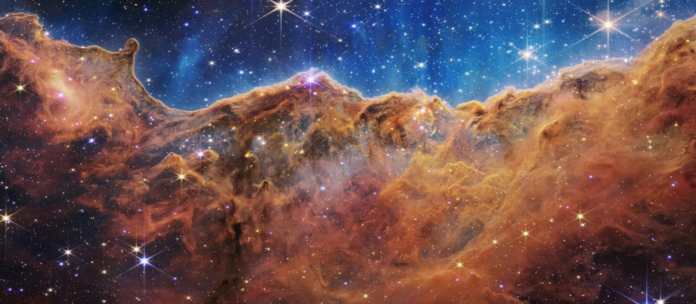NASA’s newest marvel of engineering, the James Webb Space Telescope (JWST), launched in December 2021, and is now in orbit around the sun, about 1 million miles from Earth. The successor to the famed Hubble Space Telescope, JWST spent more than a decade being designed and built. Yesterday, the world got a glimpse of the incredible detail JWST can see, with the release of its first image, an immensely deep look into a tiny patch of the night sky. Today, NASA released more initial images, depicting the spectrum of an exoplanet, a stellar nursery, a planetary nebula, and a quintet of galaxies.

A view of the edge of a nearby young, star-forming region called NGC 3324, in the Carina Nebula. Captured in infrared light by the Near-Infrared Camera (NIRCam) on NASA’s James Webb Space Telescope, this image reveals previously obscured areas of star birth. Called the Cosmic Cliffs, the region is actually the edge of a gigantic, gaseous cavity within NGC 3324, roughly 7,600 light-years away. The cavernous area has been carved from the nebula by the intense ultraviolet radiation and stellar winds from extremely massive, hot, young stars located in the center of the bubble, above the area shown in this image. #
NASA, ESA, CSA, STScI, Webb ERO Production Team

A zoomed-in crop of JWST’s first view of the Cosmic Cliffs in the Carina Nebula, revealing incredible details in the swirls of hot, ionized gas and dust streaming away from the nebula because of intense, ultraviolet radiation #
NASA, ESA, CSA, STScI / Space Telescope Science Institute Office of Public Outreach / NASA, ESA, CSA, STScI, Webb ERO Production Team

JWST’s first image, the deepest and sharpest infrared image of the distant universe to date. Known as Webb’s First Deep Field, this image of galaxy cluster SMACS 0723 is overflowing with detail. Thousands of galaxies—including the faintest objects ever observed in the infrared—have appeared in Webb’s view for the first time in this 12.5-hour exposure. This slice of the vast universe covers a patch of sky approximately the size of a grain of sand held at arm’s length by someone on the ground. #
NASA, ESA, CSA, STScI, Webb ERO Production Team

A comparison of Hubble’s previous image of galaxy cluster SMACS 0723, seen in 2017 (left), with the new, 2022 image by JWST (right), showing the increased levels of brightness and detail brought out by JWST’s observations. The 2017 image is based on observations taken by the RELICS Treasury Program, GO 14096, with the NASA / ESA HST, which is operated by the Association of Universities for Research in Astronomy, Inc., under NASA contract NAS5-26555. #
NASA, ESA, CSA, and STScI / RELICS Treasury Program-

The Southern Ring Nebula, seen in near-infrared light, by NASA’s Webb Telescope. This scene was created by a white dwarf star—the remains of a star like our sun after it shed its outer layers and stopped burning fuel though nuclear fusion. The outer layers now form the ejected shells all along this view. Over thousands of years and before it became a white dwarf, the star periodically ejected mass—the visible shells of material. As if on repeat, it contracted, heated up, and then, unable to push out more material, pulsated. Stellar material was sent in all directions, like a rotating sprinkler, and provided the ingredients for this asymmetrical landscape. #
NASA, ESA, CSA, STScI, Webb ERO Production Team

In this JWST image of Stephan’s Quintet, we see five galaxies, four of which interact. (The leftmost galaxy is actually much closer to us than the rest of the group.) The colliding galaxies are pulling and stretching one another in a gravitational dance. This mosaic, a composite of near- and mid-infrared data, is Webb’s largest image to date, covering an area of the sky one-fifth of the moon’s diameter (as seen from Earth). #
NASA, ESA, CSA, STScI, Webb ERO Production Team

A side-by-side comparison of Hubble’s 2009 image of Stephan’s Quintet (left) with the JWST 2022 version (right), showing incredible new detail within and between the larger galaxies #
NASA, ESA and the Hubble SM4 ERO Team

A closer, detailed view of NGC 7319, a distorted barred spiral galaxy in Stephan’s Quintet, and its long tidal tail stretching out to the left of the image. Hundreds of more distant galaxies can be seen in the background. #
NASA, ESA, CSA, and STScI




